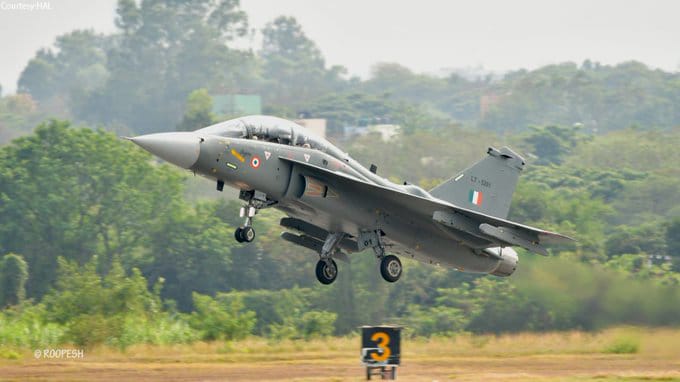Aerospace
The LCA Tejas Aircraft Crash: Understanding the Reasons – Air Marshal GS Bedi’s Perspective

Air Marshal GS Bedi, a renowned fighter jet pilot and experienced crew member, recently participated in a YouTube interview with Def Talks hosted by Aadi. During the interview, he provided insights into the recent Tejas aircraft crash in Rajasthan, which marks one of the first crashes involving an aircraft from the Tejas family since its production commenced 20 years ago.
Numerous questions have emerged regarding the circumstances surrounding the Tejas aircraft crash and the potential causes of failure. Air Marshal Bedi adeptly addressed these concerns by outlining possible scenarios that could have led to the crash. His expertise shed light on the complexities involved in such incidents and provided valuable perspective on the aviation community’s understanding of the event.
How will be the Tejas Mark 2 compared to the F-16 block 50/52? : Click here
At the outset, Tejas lacked a simulator and a trainer aircraft for initial training. However, pilots were provided with simulation trials before flying the Tejas aircraft. Initial reviews indicated stability during flight, with the aircraft maintaining a straight glide. However, there was an incident where the aircraft experienced an engine malfunction, prompting the pilot to eject safely.
Pilot Safe Ejections
The decision to eject was made as a precautionary measure, considering the aircraft’s low altitude and steep descent angle. With the aircraft’s altitude dropping rapidly, attempting to balance and land it was deemed too risky. Ejecting ensured the pilot’s safety, as deploying a parachute at such low altitudes could have been disastrous.
He chose to eject to ensure a safer distance from the ground. The aircraft is at an angle of less than 3 degrees during the approach. At a height of 100 meters, the aircraft is nearly 20 times its length away from the ground. This means the touchdown point will be approximately 4 kilometers ahead.
However, as the altitude decreases, the approach becomes too short due to the rapid descent rate. Consequently, the pilot opts to eject rather than attempt to stabilize the aircraft for a ground landing. If he had not ejected, there’s a high probability that his parachute would have deployed at that low altitude.
10 features of the fighter jet made in India, the AMCA 5.5 gen : Click here
LCA Tejas engine Issue
Investigations revealed the engine malfunction was likely due to lubrication issues or other technical faults. Such split-second decisions underscore the potentially catastrophic outcomes that can result from technical failures.
The pilot involved was highly experienced and well-trained for airshow displays, suggesting timely decision-making. Nevertheless, accidents can stem from technical glitches, human errors, or unforeseen circumstances like bird strikes.
Air Marshal Bedi emphasized the importance of pilots being trained for emergency situations, including ejecting from the aircraft when control is lost. Despite advancements in technology, technical issues remain unpredictable, necessitating ongoing learning and improvements in aircraft systems..
Today, the Tejas mk1A aircraft completed its inaugural flight at the Bangalore station, marking the dawn of a new, advanced version of the Tejas aircraft. This iteration boasts enhanced avionics and improved aircraft structure.

Aerospace
Boeing Transfers Rocket Stage to NASA, Paving Way for Human Moon Mission

Boeing has achieved a significant milestone by providing NASA with the second core stage of the Space Launch System (SLS) rocket.
This crucial component, crafted at NASA’s Michoud Assembly Facility (MAF), is set to propel the Artemis II crew into lunar orbit, marking humanity’s return to deep space after a 50-year hiatus.
The monumental Boeing-built rocket stage, the largest element of the Artemis II mission, will embark on a journey aboard the Pegasus barge, traveling 900 miles to NASA’s Kennedy Space Center.
Comparison of two legendary aircraft B777x vs B747 aircraft:Click here
Upon arrival, it will be meticulously integrated with other essential Artemis II components, including the upper stage, solid rocket boosters, and NASA’s Orion spacecraft within the iconic Vehicle Assembly Building. This intricate integration process is a vital step toward the eagerly anticipated Artemis II launch, slated for 2025.
“Boeing-built products helped land humankind on the moon in 1969, and we’re proud to continue that legacy through the Artemis generation,” remarked Dave Dutcher, vice president and program manager for Boeing’s SLS program. “Together, with NASA and our industry partners and suppliers, we are building the world’s most capable rocket and paving the way to deep space through America’s rocket factory in New Orleans.”
NASA, Lockheed Martin Reveal X-59 Quiet Supersonic Aircraft:Click here
The delivery of Core Stage 2 marks a significant achievement in the evolution of the SLS rocket. Towering over 200 feet and powered by four RS-25 engines, this core stage, coupled with two solid-fueled booster rockets, will generate a staggering 8.8 million pounds of thrust. This immense power is crucial to launching Artemis II and future missions into the vast expanse of space.
The SLS rocket stands unparalleled in its capability to transport both crew and substantial cargo to the moon and beyond in a single launch. Its extraordinary capacity will facilitate the delivery of human-rated spacecraft, habitats, and scientific missions to destinations including the moon and Mars, ushering in a new era of space exploration.
-

 Travel1 week ago
Travel1 week agoAir India to Expand US Operations with Three New Routes After a Decade
-

 Travel2 weeks ago
Travel2 weeks agoWhy We Should Avoid These Stamps in a Passport
-

 Airlines1 month ago
Airlines1 month agoInvestigations Reveal Fake Chinese Titanium in Boeing and Airbus Jets
-

 Tech4 weeks ago
Tech4 weeks agoChina’s CATL Plans 1,800-Mile Electric Plane Launch by 2027
-

 Airport3 days ago
Airport3 days agoTop 10 Largest Airports in the World by Size
-

 Aerospace4 weeks ago
Aerospace4 weeks agoChina’s Fighter Jets Turn Wings into Autonomous Drones
-

 Airlines4 days ago
Airlines4 days agoAir India Rolls Out A350s for Delhi-New York JFK and Newark Routes
-

 Defence3 weeks ago
Defence3 weeks agoBoeing Enhances Chinook with New Engines and Block II Upgrades at $96 Million







